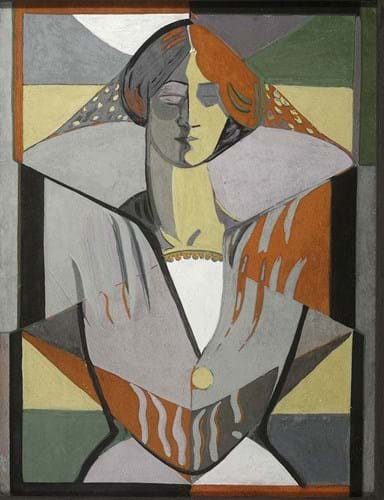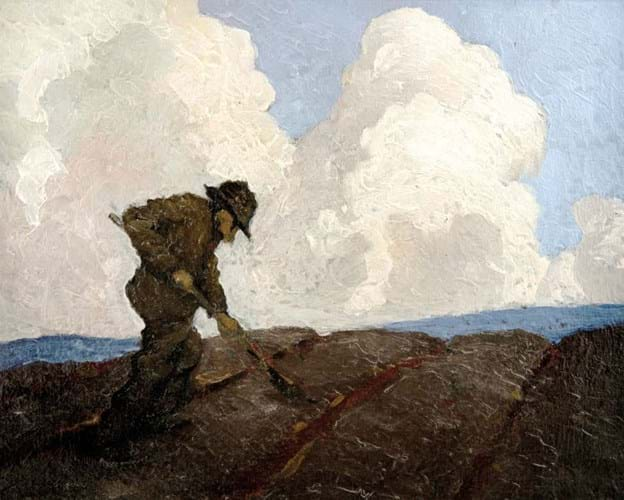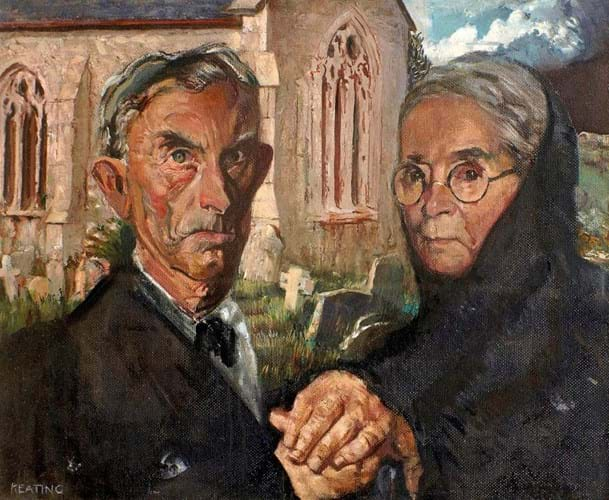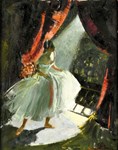The autumn sales of Irish art in Dublin kicked off with major works by artists such as Jack B Yeats and Paul Henry, but it was a painting by an often-overlooked avant-garde artist that sparked the keenest bidding.
A striking Cubist work by May Guinness (1863-1955), Women with Red Hair, was offered in a €900,000 Irish and International Art sale on September 16 at Whyte’s (20% buyer’s premium), one of three Dublin auction houses holding dedicated sales of art from the Emerald Isle.
The Dublin-born Guinness, who was a direct descendant of the Irish brewer Arthur Guinness, did not pursue art until she was in her 30s. She went on to form part of a vanguard of Irish Modernists that included Eileen Gray and Mary Swanzy, but the lack of an in-depth retrospective has hindered the recognition of her work should merit.
Given a modest guide of €6000- 8000, her 2ft 2in x 20in (66 x 51cm) oil on board was eventually knocked down to a collector in California at €34,000 (£28,000), a record for the artist at auction surpassing the €29,000 paid in 2007 for Sunday Afternoon at de Veres in Dublin.
It shows the strong influence of Cubist painter André Lhote, whom the artist studied under in the early 1920s, and also shares close similarities with her best-known work, Two Irish Girls, which was bought in 1988 for IR£13,000 at Christie’s – an auction record at the time. That work now hangs in The Merrion hotel in Dublin.
Beckett in Cubist style
Also causing a stir at Whyte’s was one of Louis le Brocquy’s (1916- 2012) Cubist-like head portraits of the Irish writer Samuel Beckett.
First shown in 1980 and later sold at an auction at Christie’s in 2006 for £190,000, it is considered a particularly fine early example which le Brocquy began painting shortly after he first met the writer in Paris in 1978. Offered here with a tentative €100,000-150,000 estimate, it went on to sell for €210,000 (£175,000) to a collector in London.
It is not the most expensive Beckett portrait by le Brocquy to have sold at auction. Prior to the financial crash a decade ago, when le Brocquy’s canvases were in peak demand, a 1979 version sold at Sotheby’s in London for £340,000, while a 1981 portrait of the Irish poet WB Yeats made €310,000 at Bonhams & James Adam in 2006.
However, a later le Brocquy still-life of fruit from 1992 failed to find a buyer at Whyte’s against an estimate of €35,000-45,000.
Another notable unsold was the sale’s potential top lot: a night-time boating scene painted in 1946 by Jack B Yeats (1871-1957) that had been in a private collection for the past 20 years. It had sold for IR£105,000 in 1999 at Sotheby’s in London but failed to find a buyer in Dublin guided at €150,000-180,000.
Central theme
Woman with Birds, a late oil by Colin Middleton (1910-83), and possibly the last version of a subject that was central to the artist throughout his career, was bought by a collector in Dublin for €42,000 (£35,000), well in excess of the €20,000-30,000 estimate.
Among the 19th century painting highlights, a large and impressive rural painting by Nathaniel Hone (1831-1917) set in County Wicklow tipped over top estimate to sell to an Irish collector at €25,000 (£21,000).
Hone was the first native artist to introduce the influence of 19th century French Naturalism to Irish painting.
Henry highest at Adam’s
The pick of the financial highlights at Adam’s (20% buyer’s premium) Irish art sale a week later on September 25 was a privately consigned early Paul Henry (1877-1958) work, Digging Potatoes.
Millet-esque in its depiction of back-breaking work and the harshness of daily routine, it was inspired by the artist’s time on Achill Island where he spoke of the ‘incessant toil with the spade’ that connected the locals to the land. It was a departure from his most commercial vistas of the west of Ireland although featuring his famous cumulonimbus clouds.
The small 13 x 16in (33 x 40.5cm) oil on panel sold for €110,000 (£91,700), above the €70,000- 100,000 guide and an improvement on the £42,000 it made at Sotheby’s in London in 2000.
A more conventional Henry landscape of Connemara complete with isolated white-washed thatched cottages and dark turf reeks, and never offered at auction before, made €120,000 (£100,000), double the lower guide.
The results bode well for Adam’s forthcoming sale of the collection of Patrick J Murphy, a former brewer at Guinness, which will be dispersed towards the end of October and includes two further Henry landscapes and works by le Broquy, Mary Swanzy and William Scott among others.
Sharing the top selling spot was Jack B Yeats’ On the Skibbereen Light Railway, which struggled to drum up much interest against a punchy €150,000-200,000 guide.
The 1920s work, whose previous owners included the 20th century art dealer Leo Smith and Modernist architect Michael Scott, was one of many Yeats painted of trains and trams. The subject allowed him to explore the interaction between people, often of different social classes, ages and genders, in physical proximity.
Lyricism and lighter hues
A Tony O’Malley (1913-2003) composition dating from his best period of painting in the 1980s improved on a €15,000-20,000 guide to sell for €25,000 (£21,000). Showcasing the lyricism and lighter tonal hues collectors admire in his work, the 3ft x 4ft (92cm x 1.22m) oil on board came from the collection of The Shelbourne Hotel in Dublin.
Competitive bidding also emerged for Red Bird, a Breon O’Casey (1928- 2011) oil on canvas that showed the strong influence of the Cornish naïve painter, Alfred Wallis. The 3ft x 4ft 2in (91cm x 1.26m) work drew multiple bids against a €4000-6000 estimate and was knocked down at €17,000 (£14,000).
Touch of Irish Gothic
Listed among the 173 lots of Irish art offered at de Veres (25% buyer’s premium with VAT) on October 8 was a Seán Keating (1889-1977) double portrait titled Irish Gothic.
It was described in the catalogue note by Dr Éimear O’Connor “as a pendant to his previous work Irish Romanesque” and a “continuation of his career-long habit to paint real people as opposed to models, all of whom had contributed to building the Irish nation in the post-Treaty years”.
Keating based the woman in the painting on his sister Vera. As she died within two years of its completion, the artist saw this painting as a tribute to her. Left unsold at de Veres in June against a €20,000-30,000 estimate, the artwork sold on the second time of asking for €18,500 (£15,500).
Campbell collection
Overall, the emphasis on this occasion centred on more affordable art, which included a collection of around 20 works by George Campbell (1917-79) from the artist’s estate.
Campbell, who first began painting during the Second World War bombing of Belfast while working in an aircraft factory, was a founding member of the Irish Exhibition of Living Art. He won, among other awards, the Douglas Hyde Gold Medal in 1966.
The subject matter encompassed landscapes and portraits in pastels, watercolours and oils with estimates starting from €200-300 with all bar a handful finding new homes.
An 18 x 15in (47 x 39cm) oil on board of a young child skipping was among the most expensive, nearly doubling its top estimate to fetch €1600 (£1300).
£1 = €1.20
















